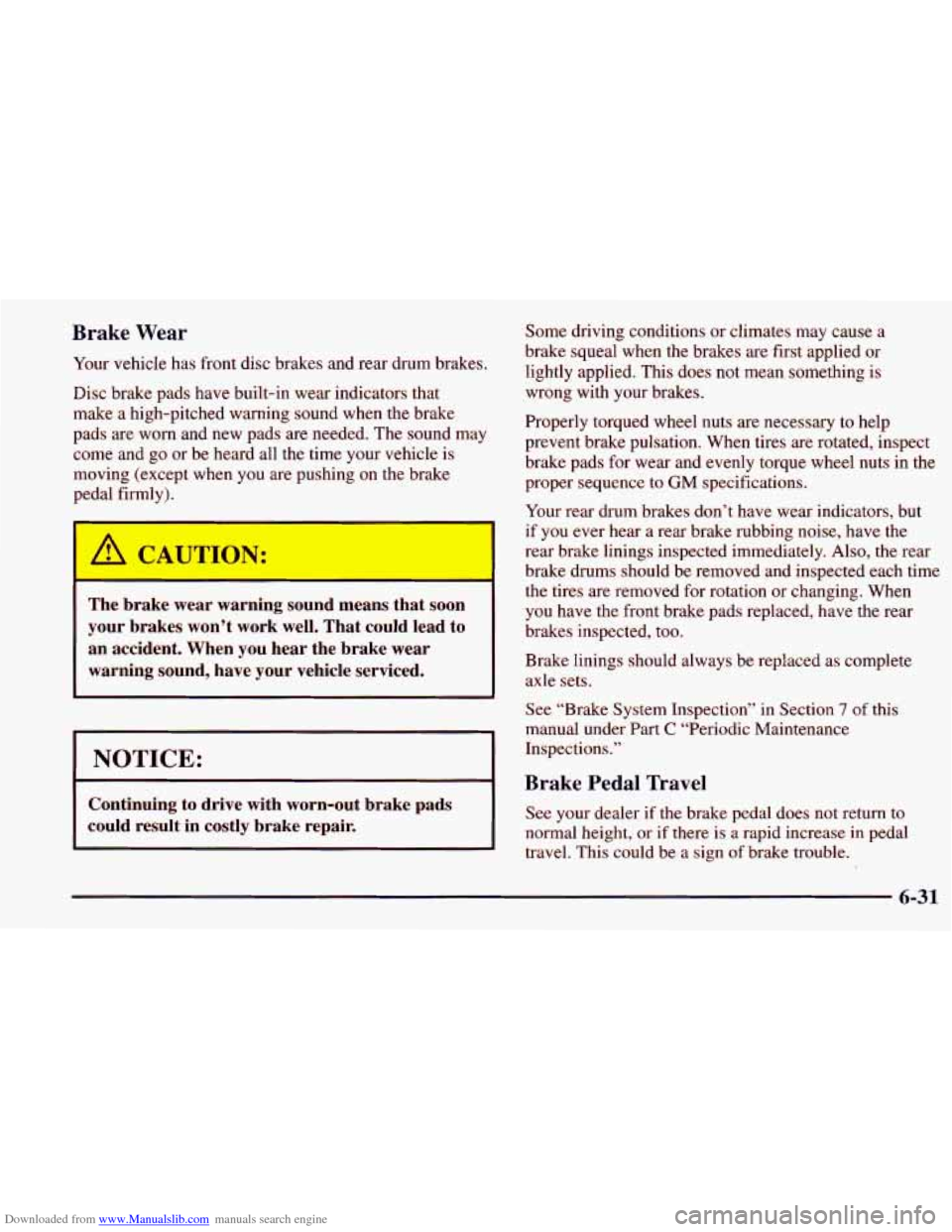Page 29 of 364
Downloaded from www.Manualslib.com manuals search engine Shoulder Belt Height Adjuster v "
Before you begin to drive, move the shoulder belt
adjuster to the height that is right for you.
To move it down, squeeze the release button and move
the adjuster to the desired position. You can move the
adjuster up just by pushing up on the shoulder belt
guide. After you move the adjuster to where you want
it,
try to move it down without squeezing the release
button to make sure
it has locked into position.
Adjust the height
so that the shoulder portion of the
belt is centered
on your shoulder. The belt should be
away from your face and neck, but not falling off
your shoulder.
1-15
Page 50 of 364
Downloaded from www.Manualslib.com manuals search engine Built-in Child Restraint (Option)
If your vehicle has this option, there’s a built-in child
restraint in the right rear seat position. This child
restraint system conforms to all applicable Federal
Motor Vehicle Safety Standards. This
child restraint is designed for use only by children
who weigh between
22 and 66 pounds (10 and 30 kg)
and whose height is between 33.5 and 50 inches
(850 and
1270 mm) and who are capable of sitting
upright alone.
The child should also be
at least one year old. It is
important to use
a rear-facing infant restraint until
the child
is about a year old. A rear-facing restraint
gives the infant’s head, neck and body the support they
would need
in a crash. See “Child Restraints” later in
this section for more information.
1-36
Page 65 of 364
Downloaded from www.Manualslib.com manuals search engine A forward-facing child restraint (C-E) positions a
child upright to face forward in the vehicle. These
forward-facing restraints are designed to help
protect children who are from
20 to 40 lbs.
(9 to 18 kg) and about 26 to 40 inches
(66 to 102 cm) in height, or up to around four years
of age. One type, a convertible restraint, is
designed to be used either as a rear-facing infant
seat or a forward-facing child seat.
1-51
Page 257 of 364

Downloaded from www.Manualslib.com manuals search engine Brake Wear
Your vehicle has front disc brakes and rear drum brakes.
Disc brake pads have built-in wear indicators that
make a high-pitched warning sound when the brake
pads are worn and new pads are needed. The sound may
come and
go or be heard all the time your vehicle is
moving (except when you are pushing on the brake pedal firmly).
The brake wear warning sound means that soon
your brakes won’t work well. That could lead to
an accident. When you hear the brake wear
warning sound, have your vehicle serviced.
I NOTICE:
I
Some driving conditions or climates may cause a
brake squeal when the brakes are first applied or
lightly applied. This does not mean something
is
wrong with your brakes.
Properly torqued wheel nuts are necessary to help
prevent brake pulsation. When tires are rotated, inspect
brake pads for wear and evenly torque wheel nuts in the
proper sequence to
GM specifications.
Your rear drum brakes don’t have wear indicators, but
if you ever hear a rear brake rubbing noise, have the
rear brake linings inspected immediately. Also, the rear
brake drums should be removed and inspected each time
the tires are removed for rotation or changing. When
you have the front brake pads replaced, have the rear
brakes inspected, too.
Brake linings should always be replaced as complete
axle sets.
Continuing to drive with worn-out brake pads
could result in costly brake repair.
See “Brake System Inspection” in Section 7 of this
manual under Part
C “Periodic Maintenance
Inspections.”
Brake Pedal Tra
See your dealer if the brake pedal does not return to
normal height, or if there is a rapid increase in pedal
travel. This could be a sign
of brake trouble.
Page 269 of 364
Downloaded from www.Manualslib.com manuals search engine Used Replacement Wheels
I
A CAUTION:
Using the wrong replacement wheels, wheel
bolts
or wheel nuts on your vehicle can be
dangerous. It could affect the braking and
handling of your vehicle, make your tires lose
air and make you lose control. You could have
a collision in which you or others could be
injured. Always use the correct wheel, wheel
bolts and wheel nuts for replacement.
I
I
NOTICE:
The wrong wheel can also cause problems with
bearing life, brake cooling, speedometer or
odometer calibration, headlamp aim, bumper
height, vehicle ground clearance and tire or tire
chain clearance to the body and chassis.
See “Changing a Flat Tire” in the Index for
more information.
A CAUTION:
Putting a used wheel on your vehicle is
dangerous. You can’t know how it’s been used or
how far
it’s been driven. It could fail suddenly
and cause an accident.
If you have to replace a
wheel, use a new GM original equipment wheel.
6-43
Page 286 of 364

Downloaded from www.Manualslib.com manuals search engine Vehicle Dimensions
Wheelbase ................ .97.1 inches (247 cm)
Length
................... 175.0 inches (445 cm)
Width
.................... .66.7 inches (169 cm)
Height
.................... .53.5 inches (1 36 cm)
Tread Front
................... .57.9 inches (147 cm)
Rear
.................... -57.5 inches (146 cm)
Air Conditioning Refrigerants
Not all air conditioning refrigerants are the same.
If the air conditioning system
in your vehicle needs
refrigerant, be sure the proper refrigerant
is used. If
you’re not sure, ask your dealer.
Normal Maintenance
Replacement Parts
Air Cleaner Filter .......... GM Part No. 94853522
Battery
............................... .35-60
Engine Oil Filter .......... GM Part No. 25014441
Fuel Filter
................ GM Part No. 94854620
PCV Valve
............... GM Part No. 94853556
Radiator Pressure Cap
........... 15 psi (105 kPa)
Spark Plug*
Denso K16TR11 ........ 0.043 inch (1.1 mm) gap
NGK BKRSEKB-11
..... 0.043 inch (1.1 mm) gap
*Your engine is fitted
with twin ground electrode spark
plugs. Use
only twin ground electrode spark plugs for
better engine performance.
6-60